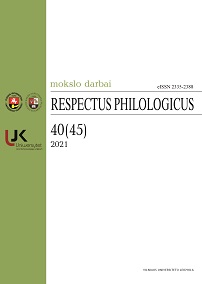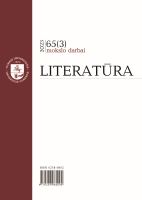The Deconstruction of National Identity in Lithuanian Literature: Marius Ivaškevičius’ Plays
A heating national identity that makes use of romantic myths from the Golden Age of Lithuania creates the necessary “emotional glue” that can bring harmony to a social group. A coherent narrative of national history together with collective memories are inseparable from the ideology of nationalism that flourished in East Central Europe in the nineteenth and twentieth centuries (Benedict Anderson). But we also have to emphasize that the impact of patriotism on a society can be compared to the ambivalent deconstructionist idea of the pharmacon, suggesting that medicine used in too great a dose may become poison. Therefore, the deconstructionist’s suspicion of national mythology and static national identity does not weaken national health, as may appear at the first glance, but may actually strengthen it. The two plays by Marius Ivaškevičius, Madagaskaras (Madagascar) and Išvarymas (Expulsion), still find a great resonance with readers and theatre audiences and are the subject of this article. I will consider how the deconstruction of national identity is based on the transformation and rewriting of national myths in Ivaškevičius’ plays. The deconstruction of identity, as I call it, emerges as a result of the interplay between opposing types of static heating and dynamic cooling identities. Having rejected extreme notions of national identity (i.e. these which are overly optimistic or utterly pessimistic) we enter into the field of the intricate semantics of identity, which leads us to the acknowledgement that nothing at all is self-evident and permanent, and everything depends on the perspective of each era. Madagascar (2004) is a symbolic memory text where the author not only rejects the Lithuanian myths concerning national identity but also renews them from the contemporary point of view by adding lots of irony. Mocking the past and the idea to create a “reserve Lithuania” on the island of Madagascar allows him to speak of the ongoing national identity crisis: the old myths are no longer valid in our rapidly changing world and we cannot find a clear-cut answer to the question of who we are. In the next play, Expulsion (2011), the author keeps investigating the same problem of national identity: “From the geographical point of view, London is located on an island. But if we were to abandon geographical thinking, all of us are islanders. Humanity still consists of islands called nations.” (Ivaškevičius) In the postmodernist global world there is no such thing as total isolation and islands are indeed interconnected by the seas rather than remaining isolated entities. This applies equally to postmodernist nations and peoples. The play depicts the dramatic integration of Lithuanian immigrants into an alien culture. Benas, them protagonist of the play, and some other young Lithuanians are brought to London as cheap illegal labour. However, the golden grindstone of the free market crushes them all. In order to survive, they must adapt in an alien culture. But are there limits to how much they are actually able to adapt? The writer describes only the destructive cases of integration and sets very relevant social and moral problems about the integration of poor emigrants from the Eastern Europe into rich Western societies. Critics like to call Ivaškevičius an anthropologist of the nation and writer of relevant political drama (Vaidotas Jauniškis, Ramunė Balevičiūtė, ValdasVasiliauskas, Kristian Lupa). We must not perceive the crisis and deconstruction of the national identity in Ivaškevičius’ plays as merely a rejection (or destruction) of past national creation myths, but rather as their ironic recreation, because, in this time of dynamic globalization, our modern national consciousness and culture needs them.
More...











